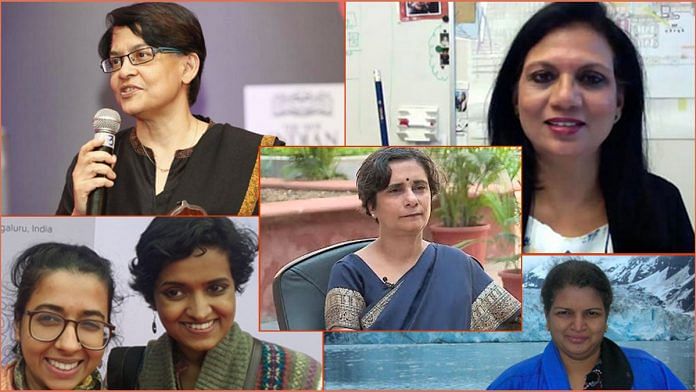Lack of advancement opportunities in science, technology, engineering, and mathematics — STEM — careers among Indian women is holding India back from realising its full potential. Women comprise only 26 per cent of India’s STEM workforce, and the percentage of female researchers is among the lowest in the world, at just 13.9 per cent. Women represent only 9 per cent of fellows in the three Indian science academies — INSA, IASc and NASI — and hold less than 5 per cent of academic department chair posts. There are many reasons Indian women don’t reach greater heights in STEM, which doesn’t only affect them but also has far-reaching implications for India’s economy and global impact.
Gender bias inhibits professional growth
India boasts exceptional, nationally and globally renowned female scientists; but for every Soumya Swaminathan, Tessy Thomas, or Gagandeep Kang who have cracked the glass ceiling, the sticky floor of scientific careers is crowded with millions of talented and aspiring Indian women and girls who have not had a chance to achieve their potential. Despite educational and professional credentialing, Indian women—along with women around the world—continue to be impeded by strong gender biases in the fields of science and research.
They are routinely directed toward less technical and less lucrative STEM fields. Mentorship and career advancement opportunities often exclude women. There is well-chronicled discrimination against women scientists in hiring, promotion, and research funding and relegation to junior roles. And, women are often subjected to hostile working environments that dismiss or ignore sexual and professional harassment. Women carry the double burden of work and domestic responsibilities, and marriage and maternity often lead to their exclusion from professional advancement.
Also read: Only 22% women in AI jobs — The gender gap in science and technology, in numbers
STEM education doesn’t means jobs, careers
Uniquely Indian gender biases also hinder advancement for women in STEM, the most pronounced being that India’s national labour market is not woman friendly. India has one of the lowest female labour force participation rates of all major economies, according to ILO estimates. Paradoxically, despite a growing economy and increases in female education, the rate has actually been declining—from 32 per cent in the mid-2000s, to 21 per cent in 2019, to only 19 per cent in 2021. This highly male-skewed job market reinforces the perverse motivation for parents to educate their daughters in prestigious scientific fields not to increase their labour market value, but to increase their marriage market value.
Indian women actually outpace men in enrolment in key scientific fields including medicine, microbiology, and information technology. However, advanced degrees do not translate into workforce participation. Latest available data on Indian medical school graduates, for example, indicate that although 51 per cent of them are female, only 17 per cent are practising physicians—a contributing factor to the lack of available doctors for a large share of the country’s population.
Systemic issue for poorer girls, women
While the gap between STEM education and STEM career is a middle and upper class story, for the 70 per cent of Indian women hailing from lower-income backgrounds, STEM education and job opportunities are virtually non-existent.
As girls, they are unlikely to complete secondary schooling, far less get a college degree, and thus are less likely to acquire credentials required for STEM careers. The untapped potential for national growth is immeasurable.
So, how do we offer a more promising future for both women and country?
Also read: These are the women in science to watch out for in India today
Inclusive investment
First, India needs to invest in education for girls and women across economic backgrounds, and facilitate school-to-work transition and career advancement. Existing successful models that mentor and sponsor girls from low-income families for STEM careers should be expanded—for example Tata Trusts’ Integrated approach to Technology in Education, Pratham’s Google.org-funded Impact Challenge for Women and Girls, INSPIRE and Vigyan Jyoti by the Department of Science and Technology (DST).
Reforms that attract women to STEM
The Indian government, private sector, and civil society must work together to enact education and employment reforms that recruit women into STEM, and that demonstrate to families the value of women’s participation in the workforce and in scientific fields. Such reforms can include pay incentives, hiring bonuses, job flexibility and must ensure absolute protection from any form of harassment.
We can build on successful programmes that promote retention of women scientists, such as WISE-KIRAN, GATI, and Mobility. Government incentives to industry to ensure a gender-balanced science and research workforce at all levels could also expand opportunities and change mindsets. Targeted social and media campaigns that recognise women as key contributors to the national economy and not just the household should be developed.
Gender equity in advancement
STEM-related employers must document, develop plans to address, and evaluate efforts to eliminate gender bias in job and funding allocations, pay scales, and promotion systems. These should include targets for career advancement for women that are equitable with the rates for men, and the data should be tracked and assessed annually. The National Commission for Women and the DST could play key roles in assessing and recognising progress.
India’s growth is not in dispute. But just imagine what the future could hold with contributions from 50 per cent more talent.
Dr Anju Malhotra is Professor of the Practice – Gender and Health, Dept. of International Health, Johns Hopkins Bloomberg School of Public Health.
Dr Amita Gupta is Co-Chair, Gupta-Klinsky India Institute, and Chief, Division of Infectious Diseases, John Hopkins School of Medicine.
Views are personal.
(Edited by Prashant)



